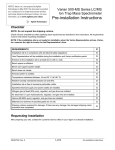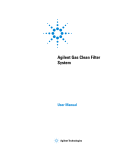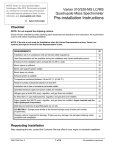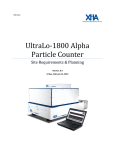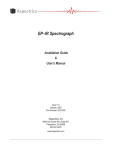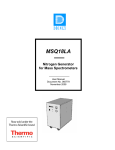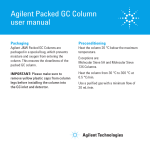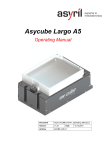Download Checklist - Agilent Technologies
Transcript
Site Preparation Guide Checklist NOTE: Do not unpack the shipping cartons. Check off each checklist box after satisfying each requirement as described in the instructions. All requirements must be met before requesting installation. NOTE: If the installation site is not ready for installation when the Agilent Representative arrives, Agilent Technologies reserves the right to invoice for the Representative’s time. Requirements Installation site is in compliance with all relevant safety regulations. User Representative will be available during the installation and certification period. Entrance to the installation site is at least 92 cm (36 in.) wide. Bench space is sufficient. Bench can support system weight, at least 114 kg (250 lb). Bench does not vibrate. Exhaust system is suitable. Temperature maintained between 16 and 30 °C (61-86 °F). Relative humidity maintained between 20 and 80%. Installation site is free of excessive particulate matter. Specified electrical supply and power outlets are installed. Nitrogen gas (at least 99% pure), regulator, and gas lines are installed. Air (less than 0.1 ppm hydrocarbons), regulator, and gas lines are installed. Helium (at least 99.999% pure), regulator, and gas lines are installed. Materials and solvents of specified grade are on site. Shipping cartons examined for damage. If there was any damage, the conditions were reported. Requesting Installation After preparing your site, contact the Customer Service office in your region to schedule installation 2 Agilent 500 Ion Trap LC/MS System/MS Site Preparation Guide Contents 1 Checklist 2 Requesting Installation 2 General Information Safety 2 Before the Installation 5 5 6 Customer Representative 6 Agilent Responsibility 6 Activities Not Covered as Part of Installation Procedure 6 Space and Weight Requirements 7 Entrance 7 Bench 7 MS40+ Foreline Pump 10 Table or Supporting Surfaces Vibration Requirements 10 Exhaust System 10 Temperature 11 Humidity 11 Particulate Matter 11 Electrical Requirements 12 1200 Infinity LC Series 13 212-LC 13 460-LC 13 500 Ion Trap LC/MS 13 Power Requirements Summary 13 Power Plugs and Cords 14 Installation Site Power 14 Qualified Computer Equipment 15 Gas Requirements 16 gilent 500 Ion Trap LC/MS System / MS Site Preparation Guide 3 Materials and Solvents 3 4 17 When the LC/MS Arrives 19 Inspecting the Shipping Cartons 19 Unpacking and Installation 20 Spare Parts and Consumables 22 System Verification 22 Preventive Maintenance 22 Trademark Acknowledgment 22 Agilent 500 Ion Trap LC/MS System/MS Site Preparation Guide Site Preparation 1 General Information The site conditions must meet the minimum specifications, before the Agilent Field Support Engineer (FSE) can proceed with the system installation. The Site Preparation Guide prepares you for each requirement of the checklist. Follow these instructions to ensure that the installation requires no more than the usual three days. Have the completed checklist available to schedule the installation. After the Agilent Representative completes the installation and it is accepted, samples can be analyzed. After meeting all of these requirements, contact the Customer Service office in your region to schedule installation. The LC/MS operates reliably under carefully controlled environmental conditions. You must provide suitable power sources, operating environment, materials, and solvents. Failures may occur if you use or maintain the system outside of the power and operating environment ranges and limits described in these instructions. CAUTION All phases of the installation site preparation must conform to local safety, electrical, and building codes. These codes take precedence over any recommendations in these instructions. Compliance is the responsibility of the customer. Safety Safety is the most important consideration for instrument use. Determine if the installation site complies with all relevant safety regulations. Check the checklist box: Installation site is in compliance with all relevant safety regulations. gilent 500 Ion Trap LC/MS System / MS Site Preparation Guide 5 Site Preparation 2 Before the Installation Customer Representative Schedule the installation when the Customer Representative will be available. One of the important duties of the Agilent Technologies service representative is to familiarize the Customer Representative with the basic functions of the LC/MS. Check the checklist box: User Representative will be available during the installation and certification period. Agilent Responsibility An Agilent Technologies service representative will install the 500 Ion Trap LC/MS and verify its performance. The service representative’s responsibilities are limited to: 1 Unpacking the 500 Ion Trap LC/MS system and verifying that all components are present and undamaged. 2 Connecting the carrier gas line to the instrument from the tank, regulators, and lines previously installed by the customer. 3 Installing, connecting, and turning on 500 Ion Trap LC/MS system components. 4 Verifying that the system meets Agilent Technologies performance standards. 5 Providing basic user familiarization for system hardware and software. 6 Signing the customer up through the Response Centers for instrument and software support. Activities Not Covered as Part of Installation Procedure Agilent Technologies is not responsible for: Any task not listed in the Agilent 500 Ion Trap System Installation Manual or in the installation guides for the LC, data system, and other accessories Installing a nitrogen gas generator and/or air compressor unless additional installation time is purchased Connecting, or verifying the performance of hardware and software not provided by Agilent Technologies NOTE 6 Items that do not include installation by Agilent Technologies must be installed by the customer. Agilent 500 Ion Trap LC/MS System/MS Site Preparation Guide Site Preparation Testing the 500 Ion Trap LC/MS system using customer standards or samples Detailed instruction in the operation of the computer operating system and Workstation software. NOTE Contact Agilent Technologies for information concerning training classes Setting up laboratory procedures. Assistance with laboratory procedures can be obtained from an Agilent Applications Engineer (AE) on a consulting basis at additional cost. NOTE Contact Agilent Technologies for information concerning assistance with laboratory procedures, application development, or chemical analysis consulting. Operation of the 500 Ion Trap LC/MS system following installation. Space and Weight Requirements Entrance Before arranging for delivery of the LC/MS, determine that there is sufficient clearance to move the shipping cartons to the installation site. The largest shipping carton is 72 cm (28 in.) wide by 92 cm (36 in.) long. If the cartons are to be moved with the pallet, at least 92 cm (36 in.) clearance is needed. Allow additional room for maneuvering the shipping containers around corners or through doors. CAUTION Check the checklist box: Entrance to the installation site is at least 92 cm (36 in.) wide. The MS, foreline pump, and LC are heavy. To prevent personal injury, use appropriate moving and lifting techniques. Bench Use the following information to plan the layout of the modules of your LC/MS system. The Agilent Representative will unpack the cartons and puts the modules on the bench. The system requires a clean, flat bench. The bench must have enough space for modules, the mouse, solvent bottles, and such. The bench must be strong enough to support the weight of the modules. If the bench is against a wall, drill a hole large enough for the vacuum tubing of your pump through the rear of the bench. The area under the bench must be large enough for the height of the foreline pump. If the bench is higher than 92 cm (36 in.) place a vibration-isolation bench under the foreline pump. The vibration– isolation bench must be capable of supporting the foreline pump. gilent 500 Ion Trap LC/MS System / MS Site Preparation Guide 7 Site Preparation The Agilent 500 Ion Trap LC/MS system is designed for indoor use at altitudes of up to 2,000 meters. Table 1 lists dimension and weight information for the 500 Ion Trap LC/MS system and related components. The installation site must have enough bench space for the 500 Ion Trap LC/MS system, LC system, data system and accessories. In addition, there must be sufficient space around the instrumentation for air flow and maintenance access. At least 30 cm (12 in) to the left of the 500 Ion Trap LC/MS and at least 15 cm (approximately 6 inches) behind the 500 Ion Trap LC/MS must kept clear. WARNING Do not stack the LC modules on top of the 500 Ion Trap LC/MS system. This arrangement is potentially unstable and dangerous. The foreline pump must be located under the laboratory bench or on the floor. It must be within the 200 cm (79 in) length of the vacuum hose. The hose exits only the back of the 500 Ion Trap LC/MS. The hose is metal and cannot be bent sharply. CAUTION Do not put the foreline pump on your laboratory bench with the 500 Ion Trap LC/MS due to the vibration that the pump creates. This vibration can lead to a loss of mass accuracy and resolution. CAUTION The supporting surface for the 500 Ion Trap LC/MS system should be kept relatively vibration free. Please refer to Table 1 for further information regarding the dimensions and weights of the 500 Ion Trap LC/MS, foreline pump, and other modules. Table 1 Product dimensions Product Width Dimensions, cm (in) 500 Ion Trap LC/MS 1200 Infinity Series LC 212-LC 460-LC without cooling 460-LC with cooling Agilent 1200 Infinity Series LC Data System 8 Weight kg (lbs) 54 (21) 62 (135) 34.5 (13.5) 48 (104) 26 (10.5) 14.5 (32) 330 (12) 19 (42) 330 (12) 21 (46) Size and weight of the LC system depends on the number and type of modules included. Most Agilent 1200 Infinity Series LC modules are approximately 35 cm (14 in) wide and 45 cm (18 in) deep. Size and weight of the Data system depends on the components included. Reserve at least 100 cm (39 in) of bench space for the data system. A typical data system weight is 23 kg (50 lb). Agilent 500 Ion Trap LC/MS System/MS Site Preparation Guide Site Preparation Check the checklist box: Bench space is sufficient. Check the checklist box: Bench can support system weight, at least 114 kg (250 lb). Please refer to Figures 1 and 2 for suggested system configurations. Figure 1 Agilent 1200 Infinity Series and the 500 Ion Trap LC/MS Figure 2 Varian 212-LC pumps and 460-LC autosampler with the Agilent 500 Ion Trap LC/MS gilent 500 Ion Trap LC/MS System / MS Site Preparation Guide 9 Site Preparation MS40+ Foreline Pump Table 2 Item Description Diameter of hole in bench, if needed Width 5.8 cm (2.3 in.) 29.7 cm (11.8 in.) Depth 41.8 cm (16.5 in.) Height 22.8 cm (9 in.) Vacuum hose length 1.8 m (6 ft) Power cord length 2.5 m (8 ft) Serial cable length 2.7 m (9 ft) Dedicated circuits 1 circuit for the MS40+ pump which can provide, 200-240 V ac, 50-60 Hz, 10A Power cord plug CEE 7/7 or NEMA 6-15P Table or Supporting Surfaces Vibration Requirements For all 500 Ion Trap LC/MS Systems, the bench or table where the instrument will be installed must be vibration free. CAUTION Do not place a HPLC modules or the CTC Autosampler on top of the instrument. These modules can cause vibrations which can affect the resolution of the instrument. Check the checklist box: Bench does not vibrate. Exhaust System Do not put the foreline pump in an enclosed space. Foreline pumps exhaust most compounds introduced into the MS and small amounts of oil vapor. Provide an adequate fume exhaust system for the outlet of the foreline pump. The foreline pump must be vented at least 2 L/min. The API spray chamber must be vented at least 20 L/min to a separate vent line. Ensure that the exhaust system does not pull a vacuum on the API chamber. Consult local regulations for the proper method of exhausting the fumes. 10 Check the checklist box: Exhaust system is suitable. Agilent 500 Ion Trap LC/MS System/MS Site Preparation Guide Site Preparation Temperature The optimal operating range is between 16 and 30 °C (61-86 F), for best mass stability, the temperature should not vary by more than ±3 °C (±5 °F) during instrument operation. NOTE As the installation site temperature increases, system reliability decreases due to heat generated by electronic components during operation. This heat must dissipate to the surrounding air for reliable operation. The airflow around the system must be adequate. The air-conditioning system must maintain a constant temperature (within operational limits) around the system. Do not place the system near air ducts, windows, or heating and cooling systems. The average steady-state heat load for the MS alone is 5200 Btu/hr, with a possible short-term heat dissipation of 8900 Btu/hr during startup. Check the checklist box: Temperature maintained between 16 and 30 °C (61-86 F). Humidity The relative humidity of the operating environment must be between 20 and 80%, with no condensation. Operating the LC/MS at a very low humidity may result in the accumulation and discharge of static electricity, shortening the life of electronic components. Operating the system at high humidity may produce condensation and result in short circuits. Use a combination temperature and humidity monitor at the installation site. Check the checklist box: Relative humidity maintained between 20 and 80%. Particulate Matter The installation site must not have excessive dust, smoke, or other particulate matter. Particulate matter may block airflow vents and cause the electronics to overheat. Check the checklist box: Installation site is free of excessive particulate matter. gilent 500 Ion Trap LC/MS System / MS Site Preparation Guide 11 Site Preparation Electrical Requirements The customer is responsible for providing appropriate electrical power and power outlets for all of the components and accessories used with the 500 Ion Trap LC/MS system. Power considerations include: Voltage ranges of major components Power requirements of major components Single-phase power configurations Power plugs, receptacles and cords 12 Agilent 500 Ion Trap LC/MS System/MS Site Preparation Guide Site Preparation 1200 Infinity LC Series See the 1200 Infinity LC Site Preparation Guide for information about the electrical requirements. 212-LC The 212-LC requires 85-264V ac; 47-63 Hz; 60 Watts; 100 VA 460-LC The 460-LC requires 95-240V ac± 10%; 50 - 60 Hz; 200 VA. 500 Ion Trap LC/MS The 500 Ion Trap LC/MS requires a separate circuit and the outlet must have adequate amperage capacity and a reliable ground. The power source must be clean and provide 200-240V ac, 50/60 Hz ±3 Hz, 1.0 kW, 10A, 1200 VA (steady state). Power Requirements Summary Table 3 Component Circuit Power Plug and Outlet Type 500 Ion Trap LC/MS 1 each 220V US: 1 each NEMA 6-15P EU: 1 each CEE 7/7 Foreline Pump MS40+ 1 each 220V US: 1 each NEMA 6-15P EU: 1 each CEE 7/7 Computer 110V or 220V, see appropriate user manual LC modules 110V or 220V, see appropriate user manual Use a separate dedicated power source for the HPLC modules, additional instruments, and equipment. Never plug the mass spectrometer and the foreline pump into the same power source or the power source may overload. Never use the free outlet on any of the power sources for equipment that draws more than 2A Table 3 and Table 4 provide information about power requirement. Table 4 Modules Max Current Draw (Amps) 500 Ion Trap LC/MS 6A Foreline Pump MS40+ 10A gilent 500 Ion Trap LC/MS System / MS Site Preparation Guide 13 Site Preparation Power Plugs and Cords Table 5 has information about the power cords and plugs. Figure 3 shows the plug types. Table 5 Power Cord 500 Ion Trap LC/MS Foreline Pump MS40+ Length 1 each 2.5 m (8 ft) 1 each 2.5 m (8 ft) Power Plug Type 1 each CEE 7/7 plugs or 1 each NEMA 6-15P 1 each CEE 7/7 plugs or 1 each NEMA 6-15P The power cables for the CPU, monitor, and printer are approximately 2.13 m (7 ft) long. They have NEMA 5-15P plugs. Figure 3 shows the conformation of the plugs and outlets. Replacing or substituting power cords or plugs must be done with strict compliance with all regulations, including electrical codes, power cord color coding, and appropriate regulatory agency certification marks. CAUTION Plugs Outlets Figure 3 Power plugs and outlets Installation Site Power The power supply for the MS and the foreline pump must be 200-240V ac. The power supply for other modules such as the LC, printer, and autosampler, can be 100-120V ac or 200-240V ac. The power supply must be stable (free of fluctuations due to slow changes in the average voltage or to changes resulting from surges, sags, or transients). 14 Agilent 500 Ion Trap LC/MS System/MS Site Preparation Guide Site Preparation A measured ground to neutral potential of greater than 3V ac or dc indicates grounding problems that may need correction before connecting an instrument module to the power source. Evaluate any power source suspected of having noise problems evaluated with a recording-type power line monitor before operating the system. NOTE Table 6 Contact your Sales Representative for a list of qualified equipment or for more information. MS Configuration Maximum Power Consumption 500 Ion Trap LC/MS without foreline pump 1200 VA 500 Ion Trap LC/MS with foreline pump 3400 VA Specified electrical supply and power outlets are installed. WARNING Do not use extension cords with the Agilent 500 Ion Trap LC/MS. Extension cords can be a safety hazard. Qualified Computer Equipment If MS Workstation or Chemstation software is to be installed on a computer not purchased from Agilent, the customer is responsible to ensure that the computer is adequately equipped and compatible with the operation of the data system and its communication interfaces. Chemstation: ask your Sales Representative for information. MS Workstation: Please check the list of requirements in the following table: gilent 500 Ion Trap LC/MS System / MS Site Preparation Guide 15 Site Preparation Agilent Technologies does not guarantee the function of the Chemstation or MS Workstation software on computer hardware or operating systems that do not meet the specified requirements. NOTE Contact your Sales Representative for a list of qualified equipment or for more information. Gas Requirements Nitrogen A nitrogen gas supply that can provide up to a maximum of 12 L/min of gas regulated at 80 psi is sufficient for ESI or APCI operation for one LC/MS. If there is more than one LC/MS, use a nitrogen supply that can deliver a maximum of 18 L/min. The nitrogen must be at least 99% pure with less than 0.1 ppm hydrocarbons and less than 1% oxygen. It must be clean and dry with a −40 °C dew point. Use a nitrogen generator, or a liquid nitrogen boil-off to supply the nitrogen gas. All nitrogen generators require regular maintenance. The customer is responsible for setting up the preventive maintenance procedures and schedules (contact the nitrogen generator manufacturer). Any MS problems caused by poor gas quality are not covered by the Warranty. It is the responsibility of the customer to conform to all regulations regarding the installation and operation of the gas system. The nitrogen supply uses ¼ in connectors. Check the checklist box: Nitrogen gas (at least 99% pure), regulator, and gas lines are installed Air 16 Agilent 500 Ion Trap LC/MS System/MS Site Preparation Guide Site Preparation A compressed air gas supply, capable of providing greater than or equal to 2 L/min of gas regulated to 80 psi with a two-stage regulator, is required as a nebulizing gas for negative ESI. The customer is responsible to conform to all regulations for the installation and operation of the gas system. The air must be clean and dry, with less than 0.1 ppm total hydrocarbons, including methane, and have a −40 °C dew point. The air supply uses ¼ in. connectors. Check the checklist box: Air (less than 0.1 ppm hydrocarbons), regulator, and gas lines are installed. Helium Use helium as the damping gas with a flow rate of 1 mL/min. Helium must be at least 99.999% pure and regulated to 40 psi (2750 bar). The minimum requirement is one 257 ft3 tank with an Alltech regulator (Part Number #AL8111) or equivalent tank and regulator. If you are concerned about the cleanliness of the helium, use a Gas Clean filter (Part Number CP17973). Check the checklist box: Helium (at least 99.999% pure), regulator, and gas lines are installed. Materials and Solvents The Agilent Representative prepares solutions to tune and evaluate the LC/MS. Please supply the materials on Table 7 Error! Reference source not found.and the solvents on Table 8. Table 7 Quantity (each) 1 100 mL clean and new volumetric flasks 3 10 mL clean and new volumetric flasks 1 Micropipette capable of dispensing 1.0 mL and tips 1 Micropipette capable of dispensing 200 μL and tips It is recommended that the highest grade solvents and chemicals available be used with the 500 Ion Trap LC/MS. Lower purity grades will result in higher background noise in the 500 Ion Trap LC/MS. NOTE Table 8 Item Quantity (each) Solvent 1 4-liter bottle LC-MS grade water, new and unopened 2 1-liter bottle LC-MS grade acetonitrile, new and unopened 1 1-liter bottle LC-MS grade methanol, new and unopened gilent 500 Ion Trap LC/MS System / MS Site Preparation Guide 17 Site Preparation Figures 4 and 5 illustrate how critical LCMS grade solvents are for optimum 500 Ion Trap LC/MS performance. The 500 Ion Trap LC/MS is sensitive enough to detect impurities in HPLC solvents which cause a very noise baseline. Figure 4 Signal-to-Noise Ratio with HPLC Grade Solvents. Figure 5 Signal-to-Noise Ratio with LC/MS Grade Solvents. The supply kit that ships with the system contains plenty of tubing for the installation of the MS, LC pumps, and LC autosampler. If additional valves or modules are to be installed then additional tubing (PEEK® or stainless steel) may be required. Please contact your sales representative if you have any questions. 18 Check the checklist box: Materials and solvents of specified grade are on site. Agilent 500 Ion Trap LC/MS System/MS Site Preparation Guide Site Preparation 3 When the LC/MS Arrives Inspecting the Shipping Cartons Do not open any shipping cartons. The Agilent Representative will open them during installation. Move the shipping cartons to a warm, dry, and secure area near the installation site. After the instrument arrives, carefully inspect the exterior of the shipping cartons for evidence of any damage that could have possibly occurred during shipment. Inspect the cartons for the following: Water stains. Cuts, punctures, or deep indentations. Crushed corners or excessively abraded edges. Arrow point on the Tip N Tell™ indicator is blue, see Table 9. ShockWatch® indicator tube is red, see Table 9. Table 9 Tip N Tell ShockWatch One indicator is on the exterior. Read and follow the instructions on the label. If the Tip N Tell arrow point is blue, the carton was on its side or tipped in transit and instrument damage may have occurred. One indicator is on the exterior. Read and follow the instructions on the label. If the tube on the ShockWatch indicator is red, the carton was dropped in transit and instrument damage may have occurred. The instrument label may be yellow, purple, or red; depending on the sensitivity of the instrument to impact that exceeds a specified G-level force. gilent 500 Ion Trap LC/MS System / MS Site Preparation Guide 19 Site Preparation If no external damage is apparent, write “Received but not inspected” on the receiving documents to indicate that the cartons were not opened. Systems are shipped either FOB Agilent or FOB Destination. The manner of shipment determines who is responsible for filing a claim against the carrier if the system was damaged in transit. Most systems are shipped FOB Agilent, so any damages incurred in shipment are the responsibility of the purchaser and the carrier. Contact your local office for assistance with filing claims and billing repairs. If the system ships FOB Destination, contact the your local office. NOTE Agilent will not accept liability for damage if obviously received damaged materials were received without noting the damage on the receiving documents. Check the checklist box: Shipping cartons inspected for damage. If there was any damage, the conditions were reported. Unpacking and Installation The Agilent Representative will review the Checklist with the customer to ensure that the site requirements were met. The Agilent Representative will unpack and install the instrument and demonstrate the fundamental operation and maintenance procedures. The User Representative must be present during the installation. The Agilent Representative will demonstrate that the system meets the performance specifications, which are on the data sheet, and any additional criteria explicitly written into the sales contract. 20 Agilent 500 Ion Trap LC/MS System/MS Site Preparation Guide Site Preparation Plan to analyze samples only after the installation is complete and the conditions of delivery are accepted. The process requires at least three days. gilent 500 Ion Trap LC/MS System / MS Site Preparation Guide 21 Site Preparation Spare Parts and Consumables Please refer to the 500-MS Ion Trap LC/MS Mass Spectrometer Hardware Operation Manual, part number 395407600, which has a list of the part numbers for spare parts and consumables. System Verification The final step in the installation process is system verification. Your Agilent service representative will test the system against Agilent standards as documented in the Agilent 500 Ion Trap LC/MS System Installation Manual or in the installation guides for the for the 500 Ion Trap LC/MS accessories you have purchased. The Agilent service representative will not test your system using your standards or samples. Furthermore, the Agilent Customer Engineer will not set up your laboratory procedures. Assistance with laboratory procedures can be obtained from your local Agilent Applications Engineer (AE) on a consulting basis at an additional cost. Preventive Maintenance The customer is responsible for performing routine and preventive maintenance of the LC, autosampler, MS, and data system. If using a nitrogen generator, perform the preventive maintenance to ensure that the nitrogen supply is clean and dry. Any instrument problems resulting from a contaminated gas supply are billable and not included in the Warranty Perform regular preventive maintenance to increase the life of the system, to maximize system uptime, and optimize system performance. Please refer to the 500-MS Ion Trap LC/MS Mass Spectrometer Hardware Operation Manual, part number 395407600, for details. The Agilent Representative will describe and demonstrate these procedures during the installation. Trademark Acknowledgment Microsoft® and Windows® are registered trademarks of Microsoft Corporation. Swagelok® is a registered trademark of Swagelok Company, Solon, Ohio. PEEK™ is a registered trademark of the Victrex PLC Company, Lancashire, England. Other brand and product names are trademarks or registered trademarks of their respective holders. 22 Agilent 500 Ion Trap LC/MS System/MS Site Preparation Guide www.agilent.com In This Book This book contains information to prepare your site for the Agilent 500 Ion Trap LC/MS system components. *395407500* *395407500* 395407500























